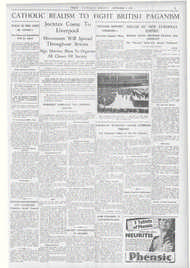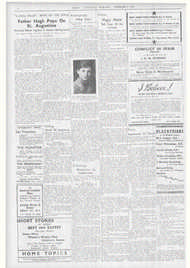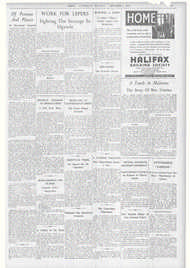Page 15, 3rd September 1937
Page 15

Report an error
Noticed an error on this page?If you've noticed an error in this article please click here to report it.
Tags
Share
Related articles
Carfin: A Living Sense Of Prayer
Carfin's Atmosphere Of Prayer
Glasgow Archdiocese Is Divided Into Three
Bishop Moriarty Dies I-memorial Font
Of Persons
Of Persons And Places
An Occasional Causerie
Canon Taylor, of Carlin. The elevation of Carfin's parish priest td the Glasgow Chapter honours a worker whose name is known far beyond Scotland, for the famous devotional shrine near Motherwell has been written of, and talked about, through, out. the English-speaking Catholic world. Among the many thousands of pilgrims, too, who have found their way to Carlin have been a great number from this side of the Tweed, as also from Ireland and even from countries overseas. Canon Taylor has been in charge there for the past twenty-two years. Fifteen years ago he opened the Grotto, hardly expecting, perhaps, that the religious appeal of that spot would elicit so wonderful a response in piety as has proved to be the case. Carfin today is dubbed " Scotland's Lourdes," a not inapt description in view of the magnitude and frequency of its pil grimages. Of Lourdes itself, as also of Lisieux and its little Saint, Canon Taylor has written; and he has also given us, in print, the story of the Scots Grotto with which his name and work are linked.
England, Scotland, Ireland. If he has not already done so, William Devlin is by now in a fair way to box the compass in Great Britain and Ireland. That he is the son of an Aberdeen man gives Scotland the first place, at any rate chronologically. Stonyhurst and Oxford were his making on the educational side, before he launched his gifts as an actor upon the English boards. And now Ireland is to come into the picture, by Mr. DevIin's arrangement to make a first appearance in Dublin, as guest artist, in The Lost Leader. Lennox Robinson's play will have a new interest for theatregoers in the Free State capital with this distinguished stage craftsman in the part of the supposed Parnell. Time will have marked many a notch in the Abbey Theatre's boards since The Lost Leader had its first production.
Itirighton is again indebted, on the Art side, to its association with Frank Brang wyn, R.A„ just as Brangwyn himself was beholden to the Corporation for some ready help when he wanted a large painting place, and repaid the debt, with interest, by presenting a splendid collection of his etchings to the town. This time it is a triple combination of B's—Belgium, Brangwyn, and Brighton, which has enriched the walls of the Municipal Art Galleries in Church Street with an exhibition of modern Belgian art. In those galleries, not very long ago, the attraction was Frank Brangwyn's art alone, for the work of this master filled two rooms. Now it is an output from various artists in his native land that Brangwyn, by his initiative, has helped to bring to a ternporary showing in Sussex. While the exhibition is on, the Southern Railway should stand to sell a good many tickets besides those bought on the strength of seaside temptations.
In song-making as in much else in which there is collaboration, it must sometimes be a moot point as to -which of the creating parties has supplied the chief factor. Is it by Gilbert's work, or by Sullivan's, for instance, that the D'Oyly Carte operas are the more celebrated? Of—shall we say" Home, Sweet Home," do the words outdo the tune, or vice versa, in sentimental regard? These reflections come to mind from the consideration that at Peter Dawson's broadcast in the National programme, on August 23, few listeners can have known that the words of "Fret-Foot " and " Old Kettledrum " were by Francis Barron, a good song-writer and, what is more important, a good Catholic. Is there any town left in the country, to say nothing of towns in the Empire overseas that has not heard one of Barron's earlier songs, " The Trumpeter "? That was a ditty given entirely to the human element in military affairs; whereas " Old Kettledrum " will keep us from forgetting that the troop horse, too, has played a useful part. Francis Barron should know, for he himself was in the Queen's Bays.
In its extensive re-naming of London's streets, the L.C.C. has not altogether over looked the claims of hagiology. "St, Chad's Street " is now indicative of a thoroughfare in St. Pancras. What is the connection, one wonders, between the Saint of Lichfield and the neighbourhood of the Gray's Inn Road? Crockford does not help us: St. Chad would seem to enjoy no titular invocation, from the Establishment, within the London area. Now in the case of " St. Anthony's Road " at Forest Gate— the credit for the re-naming in this instance goes elsewhere—we know exactly where we are and why.
Eighty-eight years of age; sixty-four years in the priesthood; fifty-seven years as parish priest of the same parish, and still upon the Church's active list, It is a wonderful tale of service that is thus presented in the case of Canon Alfred Hazeland, Lutterworth's Grand Old Man and religious force par excellence, let devotees of Wyclif say what they may. Canon Hazeland must know almost every stone in the Leicestershire town; nor is his the only instance, in the Nottingham diocese, of long association wedding the parish to the man. There are other lengthy links joining Canon West and Stamford, Canon Busch and Hathersage, Canon Lindeboom and Leicester. Some searcher, who can bring leisure as well as curiosity to the task, may perhaps be able to ascertain whether Canon Hazeland's is a record so far as England is concerned.
blog comments powered by Disqus

















